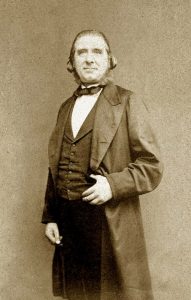Here in 21st century America, we still hear about anti-Catholic predjudices, as well as any number of “anti” predjudices. However there was a time in the history of this country, in our little corner — the Catholic Church in Indiana where anti-Catholic predjudices were in full display.
This period, particularly the mid to late 1800’s saw terrible anti-Catholic feeling. Keep in mind that it wasn’t just anti Catholic, but also anti “anything” if it had to do with immigrants in particular, be it race or religion and other factors. This was the period of American history where Nativists and Know Nothings were everywhere.
We like to think that the Church in early to mid-century Indiana was a place of peace and contentment. Catholics and Protestants and others lived side by side and no one thought the less of each other. Yet, you can read, for example, Fr. Simon Lalumiere’s 1833 letter to the Cincinnati Catholic Telegraph about a group of Protestants not wanting him to visit their area and about the cholera epidemic. He wrote that he had been “warned” by a Methodist not to visit. Lalumiere wrote:
I was lately on an extended mission towards your city, and I had the intention of paying you a visit, which I was unable to fulfil. I understood that the cholera was revisiting your city; and moreover, I was told, by a very zealous methodist, on my journey, that you had subterranean. apartments under your church, well secured by iron bars and that they were for no other purpose than to shut up protestants, indicating that the Inquisition must be in full vigor among you! You will conceive from this, that I must have been much alarmed, and even terrified by an apprehension that, coming from the backwoods of Indiana, I might be taken for a heretic, and clapped to the torture. I therefore turned myself about and devoted my attention to the duties of the mission. 1
It was also during the 1840’s that Fr. Roman Weinzapfel, a preist of the Diocese of Vincennes, stationed in Evansville, was falsely charged with rape. It turns out that the charges were brought about due to the anti-Catholic feeling in Vanderburgh County and the Evansville area.
That brings us to the 1850’s when a great deal of immigrants, particularly Irish and German immigrants were streaming into cities like Indianapolis, Fort Wayne, Evansville and other Indiana cities. The resentment felt by many, which was false resentment, led to a lot of articles and speakers who came out against anything that was Catholic.
One such speaker was Father Alessandro Gavazzi, an Italian and former Jesuit who went on a crusade against the Church. He visited North America and spoke in a number of cities, including Indianapolis.
After the fall of Rome to French troops in 1849, former Catholic priest and Italian patriot Gavazzi escaped to England where he began a vigorous campaign against the Catholic Church and the Jesuit order. He later toured Quebec, where his criticisms of papal abuses and injustice provoked riots among the heavily Catholic population. Aided by anti-Catholic and Know-Nothing groups, Gavazzi traveled through the United States warning audiences against Catholicism. Following an engagement in Cincinnati, he visited Indianapolis and spoke at the Masonic Hall on October 29-30, 1853.
In his lectures, Father Gavazzi, who was introduced by Reverend Love H. Jameson of Central Christian Church, described the Church of Rome as a system of”hideous deformity and unmitigated evil,” which neglected social problems and deprived people of their liberties. He criticized American women for wearing crosses as fashion ornamentation, urging them instead to”take the American Eagle.”
An avid nationalist, Gavazzi chastised Americans for patronizing Catholic schools and urged them to support the schools where”the mothers of Washington, Jefferson, Franklin, Webster, and Clay [received] their education.” The Indianapolis Journal reported that Gavazzi’s”patriotic outbursts were eloquent in the highest degree, and [he] elicited enthusiastic cheers from his auditors.” Following his well-received appearance, Gavazzi continued his speaking tour and later returned to Italy where he continued to fight for Italian independence and religious liberalism. 2
Prior to his visit to Indianapolis, Gavazzi was in Cincinnati and before that he was in Quebec where there were riots surrounding his visit. A good numer of people were killed in those riots. The Catholic Telegraph reported this in their June 6, 1853 issue.
Catholics in Indiana forged on, however, building more churches, schools and forming communities which sustain us to this day.
- Cincinnati Catholic Telegraph, 18 May 1833, p.2[↩]
- Encyclopedia of Indianapolis by David Vanderstel (1994) Revised February 2021 [↩]
